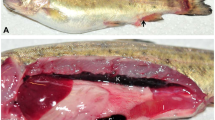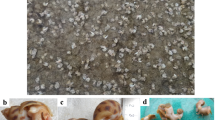Abstract
The protein expression profiles of the lymphoid organ, taken from mock and systemic Vibrio harveyi-infected Penaeus monodon at 6 and 48 h post infection, were revealed. The considerable changes in the expression level of several proteins were observed between the mock and V. harveyi-infected shrimps. From 30 analyzed protein spots with 27 differentially expressed, 21 were known proteins with the most common of these being cytoskeleton proteins (33%) which were all down-regulated upon systemic bacterial infection. Other six proteins including four proteins that are involved in the shrimp immunity (alpha-2-macroglobulin, transglutaminase, heat shock protein 1 and hemocyanin subunit Y), and two proteins that are involved in metabolism (triosephosphate isomerase) and cell signaling (14-3-3 like protein), displayed significantly decreased expression levels. There was, however, an increase in the expression level of the ATP synthase beta subunit, a protein involved in energy balance. Transcription levels of ATP synthase beta subunit and 14-3-3 like protein were up- and down-regulated, respectively, in accord with the observed protein expression levels, but the alpha-2-macroglobulin transcript levels were significantly increased in contrast to the decreased protein expression levels. Interestingly, partial gene silencing of ATP synthase beta subunit revealed a high cumulative mortality of the knockdown shrimps (73.3%) and a dramatic reduction of the total hemocyte numbers in the survival shrimps. These altered proteins are likely to play essential roles in shrimp defense against the pathogenic bacterium V. harveyi.




Similar content being viewed by others
References
Flegel TW (2006) Detection of major penaeid shrimp viruses in Asia, a historical perspective with emphasis on Thailand. Aquaculture 258:1–33
Diggles BK, Carson J, Hine PM, Hickman RW, Tait MJ (2000) Vibrio species associated with mortalities in hatchery-reared turbot (Colistium nudipinnis) and brill (C. guntheri) in New Zealand. Aquaculture 183:1–12
Thompson FL, Iida T, Swings J (2004) Biodiversity of vibrios. Microbiol Mol Biol Rev 68:403–431
Lavilla-Pitogo CR, Leano EM, Paner MG (1998) Mortalities of pond-cultured juvenile shrimp, Penaeus monodon, associated with dominance of luminescent vibrios in the rearing environment. Aquaculture 164:337–349
Austin B, Zhang XH (2006) Vibrio harveyi: a significant pathogen of marine vertebrates and invertebrates. Lett Appl Microbiol 43:119–124
Soderhall K, Cerenius L (1992) Crustacean immunity. Annu Rev Fish Dis 2:3–23
Burgents JE, Burnett LE, Stabb EV, Burnett KG (2005) Localization and bacteriostasis of Vibrio introduced into the Pacific white shrimp, Litopenaeus vannamei. Dev Comp Immunol 29:681–691
Wang HC, Leu JH, Kou GH, Wang AH, Lo CF (2007) Protein expression profiling of the shrimp cellular response to white spot syndrome virus infection. Dev Comp Immunol 31:672–686
Chongsatja PO, Bourchookarn A, Chu FL, Thongboonkerd V, Krittanai C (2007) Proteomic analysis of differentially expressed proteins in Penaeus vannamei hemocytes upon Taura syndrome virus infection. Proteomics 7:3592–3601
Bourchookarn A, Havanapan P-O, Thongboonkerd V, Krittanai C (2008) Proteomic analysis of altered proteins in lymphoid organ of yellow head virus infected Penaeus monodon. BBA-Proteins Proteomics 1784:504–511
Somboonwiwat K, Chaikeeratisak V, Wang HC, Fang Lo C, Tassanakajon A (2010) Proteomic analysis of differentially expressed proteins in Penaeus monodon hemocytes after Vibrio harveyi infection. Proteome Sci 8:39
Ponprateep S, Somboonwiwat K, Tassanakajon A (2009) Recombinant anti-lipopolysaccharide factor isoform 3 and the prevention of vibriosis in the black tiger shrimp, Penaeus monodon. Aquaculture 289:219–224
Guenal I, Risler Y, Mignotte B (1997) Down-regulation of actin genes precedes microfilament network disruption and actin cleavage during p53-mediated apoptosis. J Cell Sci 110:489–495
Grassmé H, Jendrossek V, Gulbins E (2001) Molecular mechanisms of bacteria induced apoptosis. Apoptosis 6:441–445
Tam VC, Serruto D, Dziejman M, Brieher W, Mekalanos JJ (2007) A type III secretion system in Vibrio cholerae translocates a formin/spire hybrid-like actin nucleator to promote intestinal colonization. Cell Host Microbe 1:95–107
Moss DK, Betin VM, Malesinski SD, Lane JD (2006) A novel role for microtubules in apoptotic chromatin dynamics and cellular fragmentation. J Cell Sci 119:2362–2374
Nicotera P, Bellomo G, Orrenius S (1992) Calcium-mediated mechanisms in chemically induced cell death. Annu Rev Pharmacol Toxicol 32:449–470
Luana W, Li F, Wang B, Zhang X, Liu Y, Xiang J (2007) Molecular characteristics and expression analysis of calreticulin in Chinese shrimp Fenneropenaeus chinensis. Comp Biochem Physiol B 147:482–491
Armstrong PB, Quigley JP (1999) Alpha-2-macroglobulin: an evolutionarily conserved arm of the innate immune system. Dev Comp Immunol 23:375–390
Tonganunt M, Phongdara A, Chotigeat W, Fujise K (2005) Identification and characterization of syntenin binding protein in the black tiger shrimp Penaeus monodon. J Biotechnol 120:135–145
Chotigeat W, Deachamag P, Phongdara A (2007) Identification of a protein binding to the phagocytosis activating protein (PAP) in immunized black tiger shrimp. Aquaculture 271:112–120
van Hemert MJ, Steensma HY, van Heusden GP (2001) 14-3-3 proteins: key regulators of cell division, signalling and apoptosis. Bioessays 23:936–946
Mackintosh C (2004) Dynamic interactions between 14-3-3 proteins and phosphoproteins regulate diverse cellular processes. Biochem J 381:329–342
Pongsomboon S, Tang S, Boonda S, Aoki T, Hirono I, Yasuike M (2008) Differentially expressed genes in Penaeus monodon hemocytes following infection with yellow head virus. BMB Rep 41:670–677
Guppy M (2004) The biochemistry of metabolic depression: a history of perceptions. Comp Biochem Physiol B 139:435–442
Scholnick DA, Burnett LE (2006) Impact of exposure to bacteria on metabolism in the penaeid shrimp Litopenaeus vannamei. Biol Bull 211:44–49
Devenish RJ, Prescott M, Rodgers AJW, Kwang WJ (2008) The structure and function of mitochondrial F1F0-ATP synthases. Int Rev Cell Mol Biol 267:1–58
Champagne E, Martinez LO, Collet X, Barbaras R (2006) Ecto-F1F0 ATP synthase/F1 ATPase: metabolic and immunological functions. Curr Opin Lipidol 17:279–284
Chi SL, Pizzo SV (2006) Cell surface F1F0 ATP synthase: a new paradigm? Ann Med 38:429–438
Lin X, Kim Y-A, Lee BL, Soderhall K, Soderhall I (2009) Identification and properties of a receptor for the invertebrate cytokine astakine, involved in hematopoiesis. Exp Cell Res 315:1171–1180
Hsiao C-Y, Song Y-L (2010) A long form of shrimp astakine transcript: molecular cloning, characterization and functional elucidation in promoting hematopoiesis. Fish Shellfish Immunol 28:77–86
Acknowledgments
This work was supported by research grants from the Thailand National Center for Genetic Engineering and Biotechnology (BIOTEC) and the Higher Education Research Promotion and National Research University Project of Thailand, Office of the Higher Education Commission (FW643A). Equipments are provided for by the Thai Government Stimulus Package 2 (TKK2555) under the Project for Establishment of Comprehensive Center for Innovative Food, Health Products and Agriculture. This work was also financially supported by grants from the Office of the Higher Education Commission and the Thailand Research Fund (TRF) to Kunlaya Somboonwiwat (Grant No. MRG5280119). Support from Chulalongkorn University, through the Ratchadaphisek Somphot Endowment Grants for Development of New Faculty Staff, the Faculty of Science, Chulalongkorn University (Grant No. RESA1B1-11) is acknowledged. Vorrapon Chaikeeratisak expresses his gratitude to the TRF for the fellowship under the Royal Golden Jubilee Ph.D. program.
Author information
Authors and Affiliations
Corresponding author
Rights and permissions
About this article
Cite this article
Chaikeeratisak, V., Somboonwiwat, K., Wang, HC. et al. Proteomic analysis of differentially expressed proteins in the lymphoid organ of Vibrio harveyi-infected Penaeus monodon . Mol Biol Rep 39, 6367–6377 (2012). https://doi.org/10.1007/s11033-012-1458-6
Received:
Accepted:
Published:
Issue Date:
DOI: https://doi.org/10.1007/s11033-012-1458-6




